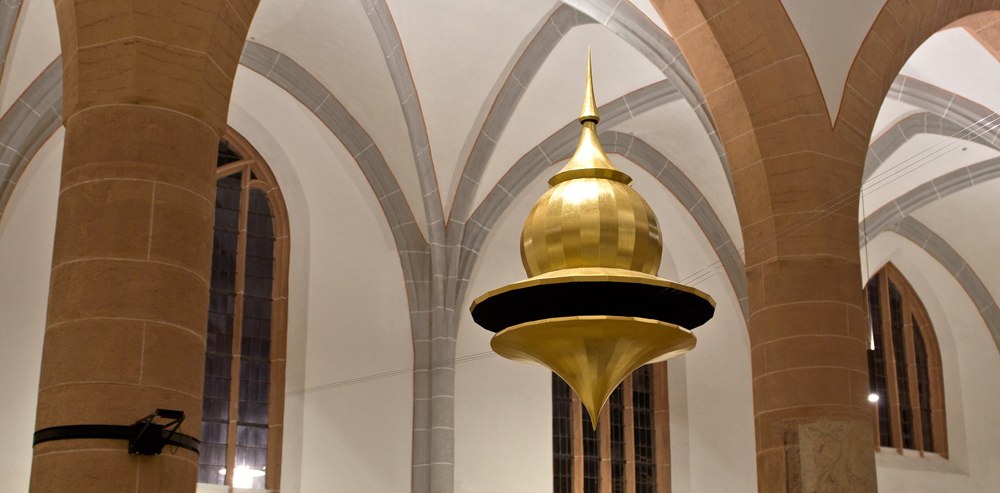Black Stupa in a Golden Age 2021
interactive sound installation
Black Stupa in a Golden Age 2021
interactive sound installation
installation view: Ortung_12, Stadtkirche Schwabach 2021
Black Stupa in a Golden Age is an interactive sound installation in the nave of the city church of Schwabach. Three parallel strings of piano wire are stretched between a pair of columns. At their center is a resonating body made of gilded wood, which acoustically amplifies the string vibrations.
The strings are set in vibration by electromagnets mounted at both pillars.
The signal which they are transmitting to the strings originates from an iPhone which is mounted on one of the pews. The phone runs an app that translates tapping and scrolling movements on the touchscreen into tones of varying frequency. The strings transform the digitally generated tones from the iPhone (tones of zeros and ones) into living sounds. The strings resonate, reverberate and interact with each other, influencing each other with their different pitches. The resulting sound image is of such high complexity that it could not easily be generated digitally - if at all. By interacting with the smartphone, visitors can play actively the installation.
Black Stupa in a Golden Age was installed in the city church of Schwabach DE on the occasion of the art biennial Ortung_12 in August 2021.
TITLE
A stupa (Sanskrit; to pile up, to accumulate) is a Buddhist sacred building. In addition to large stupas, which play a central religious role as reliquaries, there is a tradition of building smaller votive stupas to gain spiritual merit.
The construction of a stupa must be done with pure intention and under the spiritual guidance of a knowledgeable teacher. Failure to do so results in a "black stupa" ("a body without entrails" Mahayana canon), which brings misfortune to the builder.
"Golden Age" refers both to the Golden Age of ancient mythology and to the promises of the digital world.
SHAPE
The shape of the sound box is based on two forms in particular: The shape of a Buddhist stupa and that of a baroque (church) spire. Associations with vimanas (flying golden temples from Indian mythology) or pyramids are valid.
INSPIRATION
The Buddhist idea of the "Black Stupa" (basically not entirely different from the Christian concept of the Golden Calf) is emblematic of the question of para-religious aspects in our relationship and interaction with the digital world. The iPhone represents both smartphones in general and the cult-like exaltation of some tech corporations and their founders.
The smartphone is our omniscient companion, our advisor, and our direct connection to something that transcends our own existence and connects all people. For the longest time in human history, these features were reserved for divine entities or their symbiotic representations.
Our new digital companion knows our innermost. It knows things about us that we don't share with anyone and that we sometimes don't even know about ourselves. And it keeps a permanent and conscientious record of our lives. In pre-digital times, this too was reserved for divine entities.
Observing ourselves interacting with our digital friend, we may notice that we mostly turn to it when we feel alone. Our posture then often resembles that during a prayer or a moment of inner reflection.
Our digital companion and the cloud we feed through it has become an extension of ourselves. Perhaps even more than that, thinking of deceased Facebook friends whose profiles are still stored in the eternal memory of the Internet.
But what remains of the little black box in our pockets when we strip it of its central importance to our lives? An empty shell? A body without entrails? A black stupa?
Black Stupa in a Golden Age won the Art Prize of the City of Schwabach 2021
(Kunstpreis der Stadt Schwabach 2021)
>> click here for the laudatory speach by Barbara Leicht M.A. (text in English and German)
